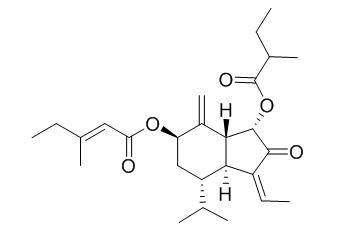7beta-(3-Ethyl-cis-crotonoyloxy)-1alpha-(2-methylbutyryloxy)-3,14-dehydro-Z-notonipetranone
7beta-(3-Ethyl-cis-crotonoyloxy)-1alpha-(2-methylbutyryloxy)-3,14-dehydro-Z-notonipetranone shows diacylglycerol acyltransferase (DGAT)1 inhibition with IC(50) values of 47.0 microM (for rat liver microsomes) and 160.7 microM (for HepG2 cell microsomes), respectively.
Inquire / Order:
manager@chemfaces.com
Technical Inquiries:
service@chemfaces.com
Tel:
+86-27-84237783
Fax:
+86-27-84254680
Address:
1 Building, No. 83, CheCheng Rd., Wuhan Economic and Technological Development Zone, Wuhan, Hubei 430056, PRC
Providing storage is as stated on the product vial and the vial is kept tightly sealed, the product can be stored for up to
24 months(2-8C).
Wherever possible, you should prepare and use solutions on the same day. However, if you need to make up stock solutions in advance, we recommend that you store the solution as aliquots in tightly sealed vials at -20C. Generally, these will be useable for up to two weeks. Before use, and prior to opening the vial we recommend that you allow your product to equilibrate to room temperature for at least 1 hour.
Need more advice on solubility, usage and handling? Please email to: service@chemfaces.com
The packaging of the product may have turned upside down during transportation, resulting in the natural compounds adhering to the neck or cap of the vial. take the vial out of its packaging and gently shake to let the compounds fall to the bottom of the vial. for liquid products, centrifuge at 200-500 RPM to gather the liquid at the bottom of the vial. try to avoid loss or contamination during handling.
Nutrients.2023, 15(6):1335.
Molecules.2020, 25(18):4283.
Analytical Letters 2021, 54(4).
Processes 2021, 9(5),894.
Foods.2021, 10(6):1378.
Russian J. Bioorganic Chemistry2024, 50:2897-2903.
Int J Mol Sci.2017, 18(5)
Hum Exp Toxicol.2017, 36(11):1169-1176
Hortic Res.2023, 10(4):uhad039.
Food Funct.2022, D1FO03838A.
Related and Featured Products
J Agric Food Chem. 2008 Nov 26;56(22):10493-7.
Sesquiterpenoids isolated from the flower buds of Tussilago farfara L. inhibit diacylglycerol acyltransferase.[Pubmed:
18937486 ]
Inhibition of acyl CoA:diacylglycerol acyltransferase (DGAT), which is a key enzyme in triglyceride synthesis in eukaryotic organisms, has been proposed as one of the drug targets for treating obesity, type II diabetes mellitus, and metabolic syndrome.
METHODS AND RESULTS:
Bioassay-guided fractionation of EtOH extract of the flower buds of Tussilago farfara , using an in vitro DGAT enzyme assay, resulted in the isolation of four known sesquiterpenoids, tussilagonone (1), tussilagone (2), 7beta-(3-Ethyl-cis-crotonoyloxy)-1alpha-(2-methylbutyryloxy)-3,14-dehydro-Z-notonipetranone (3), and 8-angeloylxy-3,4-epoxy-bisabola-7(14),10-dien-2-one (4). DGAT1 inhibitory activity was studied by in vitro DGAT assay using rat liver microsomes and HepG2 cell microsomes. They showed DGAT1 inhibition with IC(50) values of 99.2 (1), 18.8 (2), 47.0 (3), and 211.1 (4) microM (for rat liver microsomes) and >1 mM (1), 49.1 (2), 160.7 (3), and 294.4 (4) microM (for HepG2 cell microsomes), respectively. Compound 2 showed the most potent inhibition against microsomal DGAT1 derived from rat liver and human hepatocellular carcinoma HepG2 cells and also significantly inhibited triglyceride synthesis by suppressing incorporation of [(14)C]acetate or [(14)C]glycerol into triglycerides in HepG2 cells.
CONCLUSIONS:
These findings suggest that tussilagone is a potential lead compound in the treatment of obesity and type 2 diabetes.



